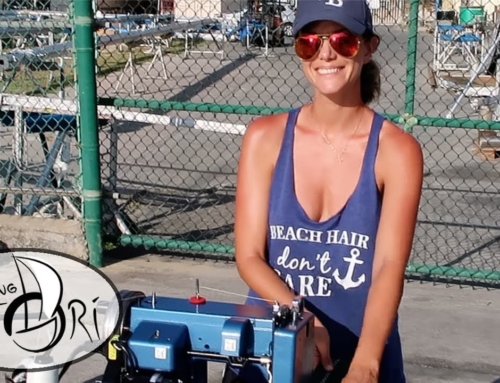When there’s a problem with the engine running, it’s almost always a fuel problem. Join Nick as he walks you through his fuel system troubleshooting process. It’s never as “easy” job!
Engine Failure
After a beautiful day sail from Luperon to Cambiaso, on the North shore of the Dominican Republic, Satori’s engine stalled out as we entered Luperon harbor. The protected bay was a saving grace as it allowed the us to drop the dinghy off the davits and hip-tie it to Satori. Using the dinghy motor as auxiliary power, the helmsmen can continue to steer as normal. This technique allowed us to get Satori back to the Mooring safely.
Clogged Fuel Filters
The first step when troubleshooting a fuel system failure is to check the fuel filters. In Satori’s case, the first line of defense is her set of Racore water separating fuel filters. By inspecting the fuel filters and filter bowl, you should quickly be able to see if they have become clogged or water saturated. In this case, the filters were discolored, but far from being completely clogged. The bowl did have some sludge in the bottom, leading me to believe that there is some kind of growth happening in the tank.
Diesel Bug
When water enters a diesel tank, either for contaminated fuel, rain intrusion, or condensation, it settles to the bottom of the tank and remained separated from the diesel. This moisture allows a special kind of algae and fungus to feed off the diesel fuel and grow in the tank… Crazy, I know! After some hard learning, I suspect that the moisture and algae entered the tank in 2 ways:
First, I had 2 jerry cans on deck that were holding fuel I obtained locally in Luperon. The fuel itself seemed clean enough, but after I siphoned the fuel into the tank, I noticed there was some algae growth in the bottom of the jerry can. This could have been the introduction of the diesel bug into my tanks, or more likely, the algae was already prone to grow in the local fuel I had already put into my main tanks.
Second, I was not keeping my fuel tanks full, as Like I should have. They should be kept full, or close to full at all time, especially during hurricane season. Keeping the tanks full also reduces the amount of condensation that can develop on the inside of the aluminum tank walls, inevitably collecting in the bottom of the tank. This type of moisture can provide a cozy breeding ground for the dreaded diesel bug.
Fuel Flow
The main goal of the fuel system is to provide fuel to the engine. Pretty simple, huh. If that flow is interrupted, the engine will struggle to keep running or stop all together. After determining that the fuel filters are relatively clear, it help to visually see the floe of fuel.
I like to remove the fuel line, or in the case of this video, the fuel filter canister, at the engine. This is the end of the line for the fuel supply. If you can prove the fuel is making it to the engine with a healthy flow, your system is clear. Any problems remaining after this point will largely have to do with the injection system.
In this case, we were not getting and fuel to the engine. Years ago, I installed an electric fuel pump after the mechanical lift pump on my Yanmar 4JHBE went bad, leaving my stranded off the gulf coast of FL on an overnight solo sail back to St. Petersburg. The wind had died, then shifted north on my nose. As I began to tack, the wind shifted more and more out of the Northeast… without an engine, it was going to be a long night!
I eventually realized I could use the primer bulb from my dinghy to act as a temporary fuel pump. I went below deck, cut my fuel line, and installed the bulb. For the next 7 hours, I was able to pump that bulb every 15 minutes and maintain a cruising speed while motor sailing. I dropped the hook at 2am, them brought her into the dock once I had a helping hand on the dock. I didn’t want the engine to stall out while trying to dock solo at 2am, exhausted and sleep deprived.
That electric fuel pump engaged when the ignition key is turned on. A pump like this will allow you to troubleshoot a fuel system without having to start the engine. In this case, the pump was not delivering any fuel to the engine. I also installed a back-up fuel pump into my existing “fuel-polishing” setup. This pump was certainly undersized, but help me prove that there was an obstruction up stream somewhere.
Clogged Fittings
Satori’s Fuel system has had some modification in the past. In particular, the addition of a second fuel tank and the fuel polishing system. There are also a few coupler fitting used to extend the existing fuel lines. All of these additional valves and fitting create a potential blockage point for anything that gets sucked up from the tank, not to mention the tank pick-ups themselves.
This makes finding a clog on Satori a major challenge. After verifying that the tank pickup was clear, I started at the tank selector valves and fitting. Sure enough, a beautiful snot glob of diesel growth was trapped in the valve housing. Unfortunately, this was not the only obstruction as I still could not get fuel pumping to the engine.
I decided to break out the dinghy pump and attempt to blow the lines clear. This was a far less labor intensive job than removing and clearing each and every section of hose, fitting, and valve. I was unable to blow the line back, but was somehow able to blow them forward. There were no obvious signs of a clog in the dispensed fuel, which makes for an uneasy feeling, but the line were now clear and fuel was moving freely.
Clean the Fuel
The next step is to thoroughly clean the fuel and the tanks. Unfortunately, this is not an easy task due to the way most fuel tanks are made. Most tanks come with only one inspection port, as is the case with both of Satori’s tanks. Satori’s tanks also have baffled sections to prevent the fuel from violently sloshing back and forth in rough seas. These baffles serve an important purpose, but also cause sections of the tanks to be unreachable without taking drastic measures (i.e. cutting a bunch of holes in the tanks). In our next blog/video, we will do our best to clean the tanks and polish the fuel without getting the saw out.
|
ReplyForward
|







